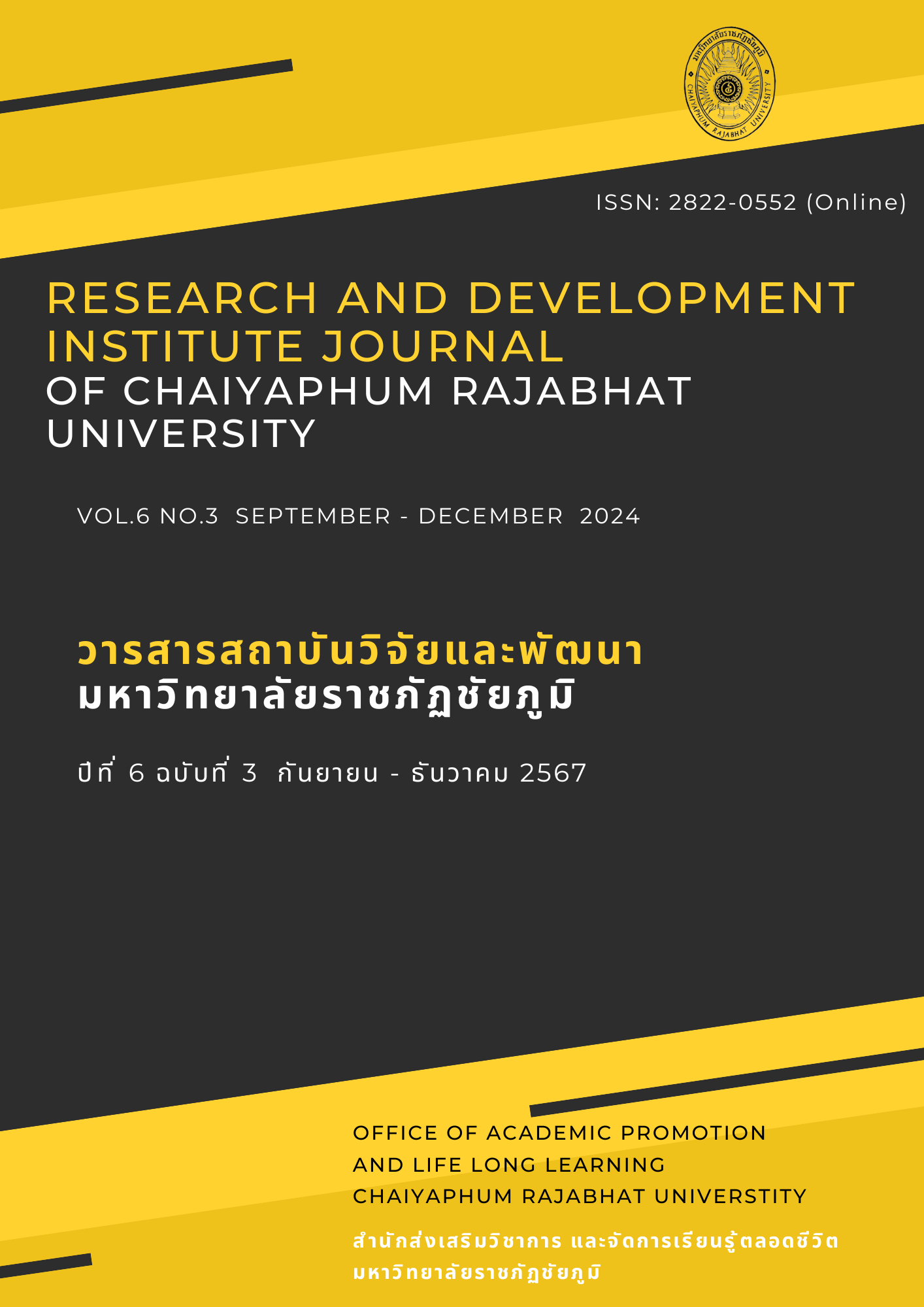5-STEP OF INQUIRY-BASED LEARNING WITH ONLINE YOUTUBE LESSONS ON COAL AND PETROLEUM FOR STUDENT ACADEMIC ACHIEVEMENT AND LEARNING SATISFACTIO
Main Article Content
Abstract
This study aimed to: 1) develop a 5-step inquiry-based learning approach using YouTube online lessons on the topics of Coal and Petroleum, ensuring efficiency based on an 80/80 criterion; 2) compare students' academic achievements before and after implementing the 5-step inquiry-based learning with these online lessons; and 3) assess learners' satisfaction with this instructional method. The sample included 16 students enrolled in the Energy Science course during the first semester of the 2024 academic year at Rajabhat Maha Sarakham University. The research tools included: 1) four online YouTube lessons on Coal and Petroleum, 2) a structured plan for 5-step inquiry-based learning with YouTube lessons on these topics, 3) pre- and post-learning achievement tests, and 4) a satisfaction questionnaire regarding the 5-step inquiry-based learning experience with YouTube lessons. Data analysis involved t-tests, mean scores, percentages, and standard deviations. The results indicated that: 1) the 5-step inquiry-based learning approach with YouTube lessons on Coal and Petroleum achieved an efficiency score of 82.50/81.38, surpassing the target criterion; 2) post-learning achievement scores were significantly higher than pre-learning scores at the .05 level; and 3) learner satisfaction with the 5-step inquiry-based approach using YouTube lessons was high.
Article Details

This work is licensed under a Creative Commons Attribution-NonCommercial-NoDerivatives 4.0 International License.
Permission to use text, content, images, etc. of publication. Any user to read, download, copy, distribute, print, search, or link to the full texts of articles, crawl them for indexing, pass them as data to software, or use them for any other lawful purpose. But do not use it for commercial use or with the intent to benefit any business. Published under a Creative Commons Attribution-NonCommercial-NoDerivatives 4.0 International License.

This work is licensed under a Creative Commons Attribution-NonCommercial-NoDerivatives 4.0 International License
References
Bransford, J.D., Brown, A.L., & Cocking, R.R. (2000). How people learn. National Academy Press.
BSCS Science Learning (2019). BSCS 5E instructional model. Retrieved from: https://bscs.org/bscs-5e-instructional-model/
Bybee, R., Taylor, J., Gardner, A., Scotter, P., Powell, J., Westbrook, A., & Landes, N. (2006). The BSCS 5E instructional model: Origins, effectives, and applications. BSCS.
Bybee, R. W. (2009). The BSCS 5E instructional model and 21st Century Skills. BSCS.
Colburn, A. (2000). An inquiry primer. Science Scope, 23(6), 42-44.
Colburn, A. (2007). Constructivism and conceptual change, part II. The Science Teacher, 74(8), 14.
Duran, L. B., & Duran, E. (2004). The 5E instructional model: A learning cycle approach for inquiry-based science teaching. Science Education Review, 3(2), 49-58.
Keselman, A. (2003). Supporting inquiry learning by promoting normative understanding of multivariable causality. Journal of Research in Science Teaching, 40(9), 898-921.
Kong, S.C., & Song, Y. (2014). The impact of a principle-based pedagogical design on inquiry-based learning in a seamless learning environment in Hong Kong. Educational Technology & Society, 17(2), 127-141.
Koseoglu, F., & Tumay, H. (2010). The effects of learning cycle method in general chemistry laboratory on students’ conceptual change, attitude and perception. Journal of Kirsehir Education Faculty, 11(1), 279-295.
Likert, R. (1961). New pattern of management. McGraw–Hill.
Lord, T. R. (1999). A comparison between traditional and constructivist teaching in environmental science. Journal of Environmental Education, 30(3), 22-28.
Lord, T., & Orkwiszewski, T. (2006). Moving from didactic to inquiry-based instruction in a science laboratory. American Biology Teacher, 68(6), 342-345.
Marshall, S. P. (2009). Re-imagining specialized STEM academies: Igniting and nurturing decidedly different minds, by design. Roeper Review, 32(1), 48-60. https://doi.org/10.1080/02783190903386884
Miller, H., McNeak, K., & Herbert, B. (2010). Inquiry in the physical geology classroom: Supporting students’ conceptual model development. Journal of Geography in Higher Education, 34(4), 595-615.
Minner, D.D., Levy, A.J., & Century, J. (2009). Inquiry-based science instruction – What is it and does it matter?. Journal of Research in Science Teaching, 1-24.
National Research Council, (2000). Inquiry and the National Science Education Standards: A guide for teaching and learning. National Academies Press.
Pedaste, M., Mäeots, M., Leijen, A., & Sarapuu, T. (2012). Improving students’ inquiry skills through reflection and self-regulation scaffolds. Technology, Instruction, Cognition and Learning, 9(1-2), 81-95.
Sandoval, W.A., & Reiser, B.J. (2004). Explanation-driven inquiry: Integrating conceptual and epistemic scaffolds for scientific inquiry. Science Education, 88(3), 345-372. https://doi.org/10.1002/sce.10130
Secker, V.C. (2002). Effects of inquiry-based teacher practices on science excellence and equity. The Journal of Educational Research, 95(3), 151-160.
Varma, T., Volkmann, M., & Hanuscin, D. (2009). Preservice elementary teachers’ perceptions of their understanding of inquiry and inquiry-based science pedagogy: Influence of an elementary science education methods course and a science field experience. Journal of Elementary Science Education, 21(4), 1-22.
Wilder, M., & Shuttleworth, P. (2005). Cell inquiry: A 5E learning cycle lesson. Science Activities, 41(4), 37-43.
Wilke, R.R., & Straits, J.W. (2005). Practical advice for teaching inquiry based science process skills in the biological science. The American Biology Teacher, 67(9), 534-540.

